2017
December
26-31
|
And that was 2017
We are much better off at the end of 2017 than we were at the
beginning.
The avid reader may remember that a year ago, Melody was in a convalescent center
after the fourth of what turned out to be six hip surgeries.
These days, Melody is up and about (she's buying groceries by herself as I write this),
is cooking delicious meals for us, and Sharon has made considerable headway recovering
from the nerve injury that has plagued her for six years.
Thanks to Melody's healthy cooking, we have even lost weight.
My consulting business is prospering, almost too much!
A major client closed for the holiday week, and then some of their customers
piped up and wanted things, and I've been very busy since December 27 or so.
I'm taking Dec. 31 to Jan. 2 off, or maybe not Jan. 2, depending on how
things go.
There are only two things wrong. We didn't get to see the grandchildren this year,
except for Emily's visit. And my sister's husband is seriously ill.
But he's recovering, and we'll head off to see the grandchildren when the
weather warms up.
Coming to the Daily Notebook in 2018:
- A new book
- A new piece of free software
So stay tuned!
Permanent link to this entry
Another calendar hoax
Did you hear that 1/1/2018, 2/2/2018, 3/3/2018, etc., will all be Sundays?
Pass it on!
It's not true, of course.
This close to 1/1/2018, people should be catching on that it's not a Sunday.
And if it were, 2/2/2018 would only be a Sunday if January had 34 days
(or 27, or some other stranger possibilities).
The week is 7 days long, so the interval from one Sunday to the next
has to be a multiple of 7 days.
Why do people spread things like this?
Permanent link to this entry


|
2017
December
25
(Extra)
|
Christmas came

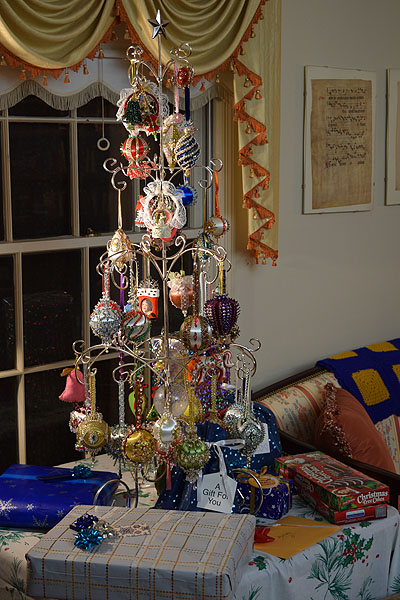


This year we had the most normal Christmas in several years, with much to be
thankful for. Melody's hip problem is on the mend, and Sharon's neuropathy is
under control. Cathy, Nathaniel, and the grandchildren weren't able to come
(nor could we go visit them), but they are as close as Skype, and when the
weather is a little warmer, we'll make the trip north.
Last year, you'll recall, Melody spent Christmas at a convalescent facility right
after her hip operation. This year, she was at home and ambulatory.
Top to bottom, in the pictures you see our tree and wreath as seen from outside;
the tree in more detail, actually a display of ornaments Melody made over the years;
our "horizontal-format Christmas tree" (garland on the mantelpiece, including a view
of Johnny Tremain's stagecoach, which Melody and her father made when she was in
middle school, and the white ceramic tree, about 50 years old but new to us this year);
and Melody making our traditional Christmas lasagna, a tradition
we picked up from the late Bob and Jeanie Lucas when we were newlyweds in California.
Our gifts were on a modest scale because we sent a lot to the grandchildren and because
we had just had two major acquisitions, my laptop and a new recliner chair mostly used
by Sharon. The best thing I got was simply some time left to my own devices.
Starting December 21,
I took a break from consulting work in order to make a deep dive into revising
Digital SLR Astrophotography. Today will be a day in the workshop (perhaps my
first in two years), and then tomorrow the grind resumes — my consulting business
is thriving, but of course the work only pays off when I actually do it!
Permanent link to this entry


|
2017
December
16-24
|
How did Tycho Brahe polar-align the Great Equatorial Armillary?
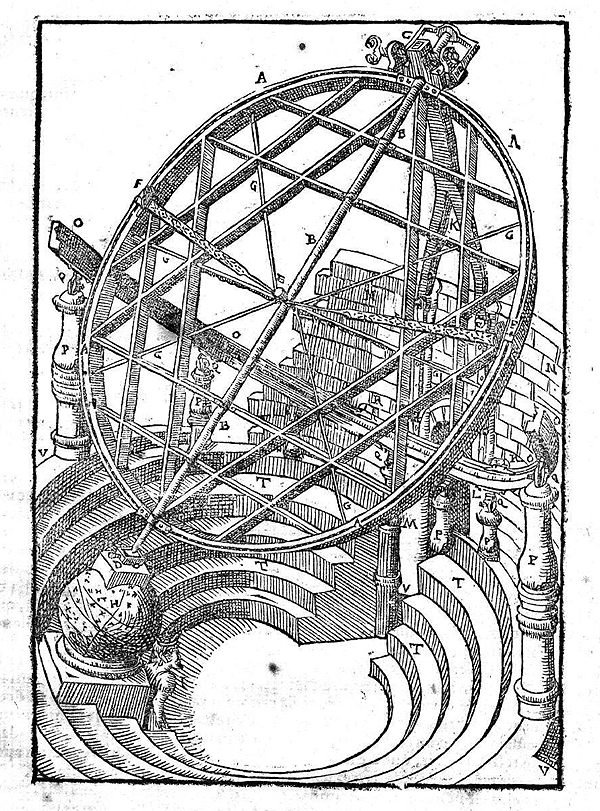
The last great pre-telescopic astronomer was
Tycho Brahe (1546-1601).
Above is a picture you've surely seen, of his most grandiose instrument.
It's for measuring the right ascension and declination of stars to an accuracy of
(believe it or not) 1 arc-minute (yes, he really achieved that).
The big circle with struts across it (A A A A) is the main surface of the instrument.
It revolves around the main axis (C D), which is parallel
to the axis of the earth. Measurements are taken by sighting stars and reading
the numbers on the rings showing the position of the sighting bar on the main surface A
and the position of the main surface within the large ring O in which it rotates.
How did Tycho align his instrument with the axis of the earth?
Was it anything like the
drift method
that I use to align my telescope mount?
That is did he sight a star, then turn the instrument
as the earth rotated and see if it stayed pointed
at the star?
Tycho, not the most organized of writers, describes this instrument in
three works, his Astronomiae
Instauratae Mechanica (Instruments),
his Progymnasmata
(Preliminary Exercises), and
Epistolae (Letters, p. 246 ff.;
on p. 246 the page number is misprinted 226).
These are in Latin, but an English translation of the Mechanica was
published in Denmark in the 1940s and contains useful commentary.
The instruments are also described in
Dreyer's excellent biography of Tycho.
The bottom line is that he never says how he did polar alignment.
We know that he did it, both because he talks repeatedly about how carefully and
accurately the instrument was aligned, and because later analysis of his measurements
has shown that he kept the alignment error under 1 arc-minute, which is good
by telescopic standards and astonishing when you consider that Tycho didn't have
telescopes or digital image sensors.
His accuracy was investigated by C. H. F. Peters in Astronomische
Nachrichten, 1849 (issue 688, vol. 29 p. 241) — actually this reference jumps into the
middle of a multi-part article.
The bottom line? He probably did polar alignment by checking everything he could think of.
Two methods stand out as likely.
One is similar to the modern drift method — measure the declination of the same star
at different points in its passage across the sky, and if the measurements disagree,
calculate the error of the axis.
The other is to read the position of a star, then flip the instrument over and read it again.
The difference between the two is twice the polar alignment error in the plane of the
instrument. Naturally you have to do it at least twice, in perpendicular directions.
Permanent link to this entry
Tycho's strange term pinnacidium
Let me sketch another odd research trail that I decided to follow.
Tycho regularly calls the sighting-mark on an instrument the pinnacidium.
That is a word I can find in no Latin dictionary, not even medieval ones.
I am not sure it is original with Tycho, but it certainly isn't classical.
If he had said pinnaculum it would have made perfect sense; that word
means "peak" ("pinnacle") and could even mean "spike."
He could also have said pinnula with much the same meaning; that word
became English "pinnule" in later descriptions of old instruments.
But pinnacidium looks like it ought to mean "the killing of a feather"
(compare fratricidium and the like). How did he come up with that?
My theory is that someone misread pinnaculum, in wavy medieval cursive
handwriting, as pinnacidium, and then it stuck.
The sociolinguistic factor at work is that people like to use technical jargon.
Note added Dec. 2018:
The Greek word pinakidion 'writing tablet' would go into Latin as pinacidium
with one n. It is the diminutive of pinax 'tablet, panel, platter'.
Both words were very common and in fact occur in the New Testament.
Neither one means quite what we need here — unless maybe pinakidion
was borrowed into Latin to describe the labeled panel that a pointer pointed to,
and then came, by metonymy, to mean the pointer itself, while at the same time
picking up an extra n by false analogy to pinna.
Permanent link to this entry


|
2017
December
15
|
More old tricks from a new dog: Pleiades
Continuing to test the Nikon 180/2.8 ED AI-S lens, the other evening
I also photographed the Pleiades star cluster.
This is a fairly average-looking picture of the Pleiades,
showing the star cluster and some of the interstellar dust.
I want to do this again from a darker site and photograph much
more of the dust.
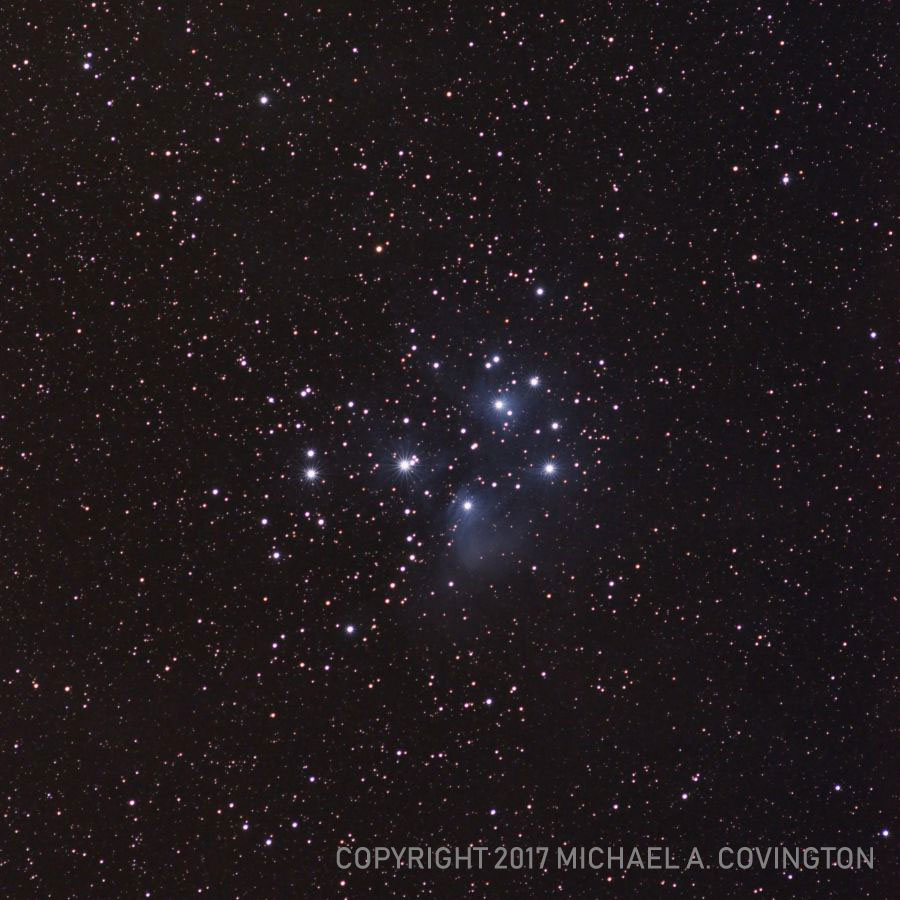
Not quite the full picture; cropped a little in the short dimension and a lot
in the long dimension, so that it came out square.
Stack of ten 2-minute exposures, Canon 60Da (ISO 800), at f/2.8.
Permanent link to this entry
Orion Nebula (M42)
This time of year can hardly go by without a picture of the Orion Nebula.
Again, I'm not breaking new ground here, just testing a lens.
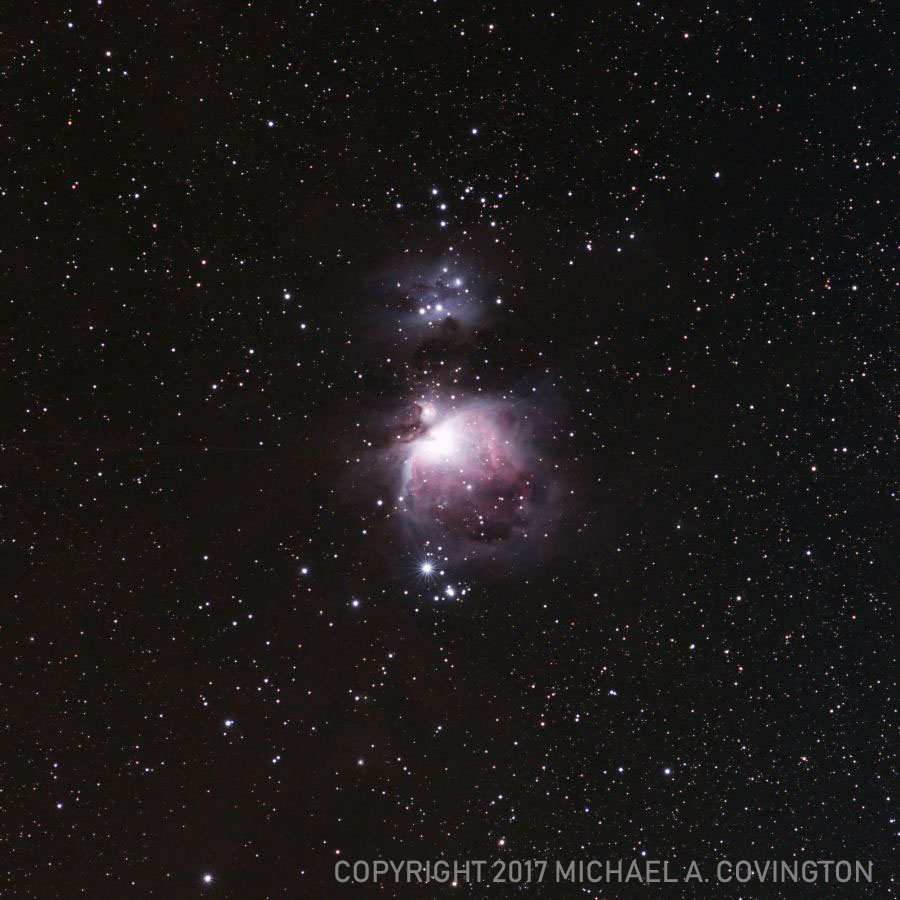
Stack of nine 2-minute exposures, otherwise the same as the picture above.
Permanent link to this entry
Flaming Star Nebula (IC 405)
Now for something a bit more récherché, though still photographed from my
backyard under 4th-magnitude skies.
The main nebula in this picture is IC 405, which, as its name indicates,
didn't make it into the Messier (M) catalogue or the New General Catalogue (NGC).
It was discovered later, on photographs, by J. M. Schaeberle in 1892, though
it can be seen with telescopes (some nebulae can't).
The star's motion shows that it originated long ago in or near the
Orion Nebula, then moved away at a high speed.
It is now moving through, and illuminating, this unrelated nebula.
In fact the side of the nebula through which the star arrived
seems to be missing (or rather much thinner), as if the star had absorbed it.
Another nebula and star cluster are at the lower left.
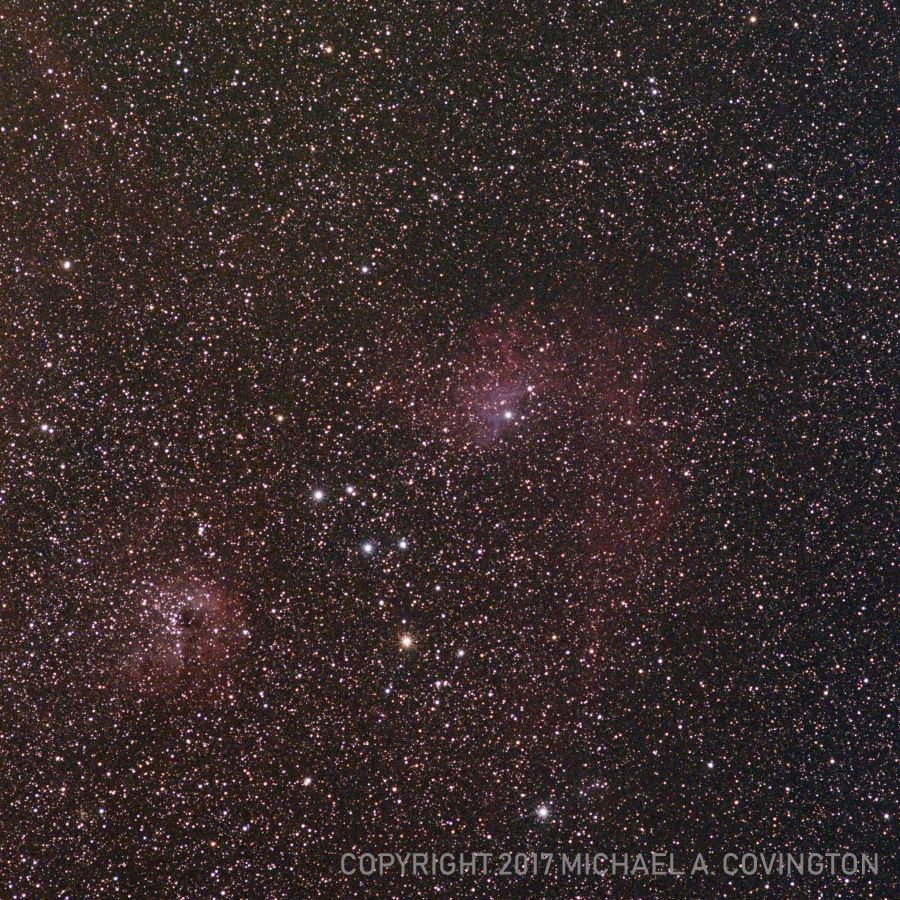
Stack of eight 2-minute exposures.
I very much want to re-do this picture at a darker site;
the main thing is, I've shown I have the right lens and mount
for doing that.
This picture looks a bit rougher than the others
because its contrast was boosted more.
Permanent link to this entry
Geminid meteors
I had a good time watching the Geminid meteors on the evening of the 13th.
From my driveway, with stars visible only to 4th magnitude (which is lamentable),
I nonetheless saw 18 meteors in 40 minutes.
I'm not sure whether they all belonged to the Geminid shower,
but most did.
Meteors are hard to photograph because they move fast; they always look fainter
on the picture than comparable stars do.
Here are two, both caught on a single 3-minute exposure.
I was using a Nikon D5300 with its "kit lens" (18-55 mm zoom) at 18 mm, f/3.5.
This picture required heavy processing because the meteors were near the edge
of this cropped picture, and the lens has severe edge darkening.
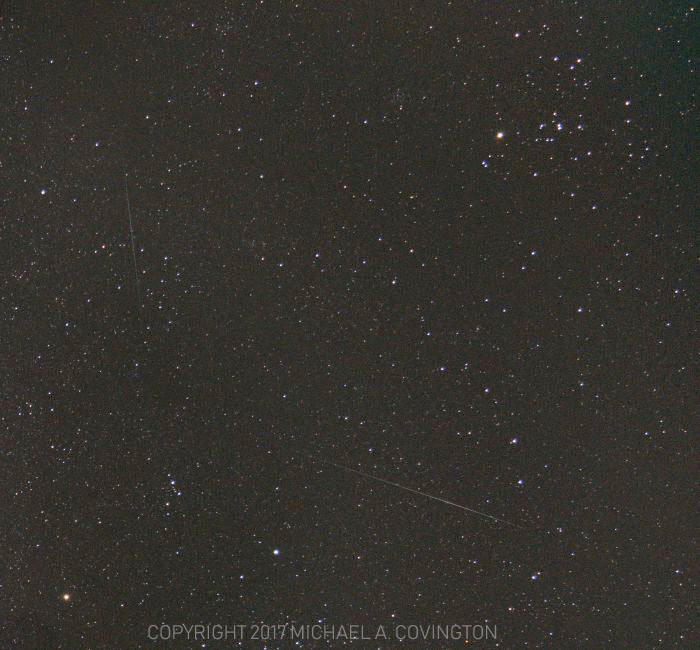
Permanent link to this entry


|
2017
December
11-12
|
Teaching a new dog old tricks:
astrophotography with a classic lens
By "teaching a new dog old tricks" I mean using a new (to me) lens
to take pictures very much like pictures I've already taken,
to evaluate the lens.
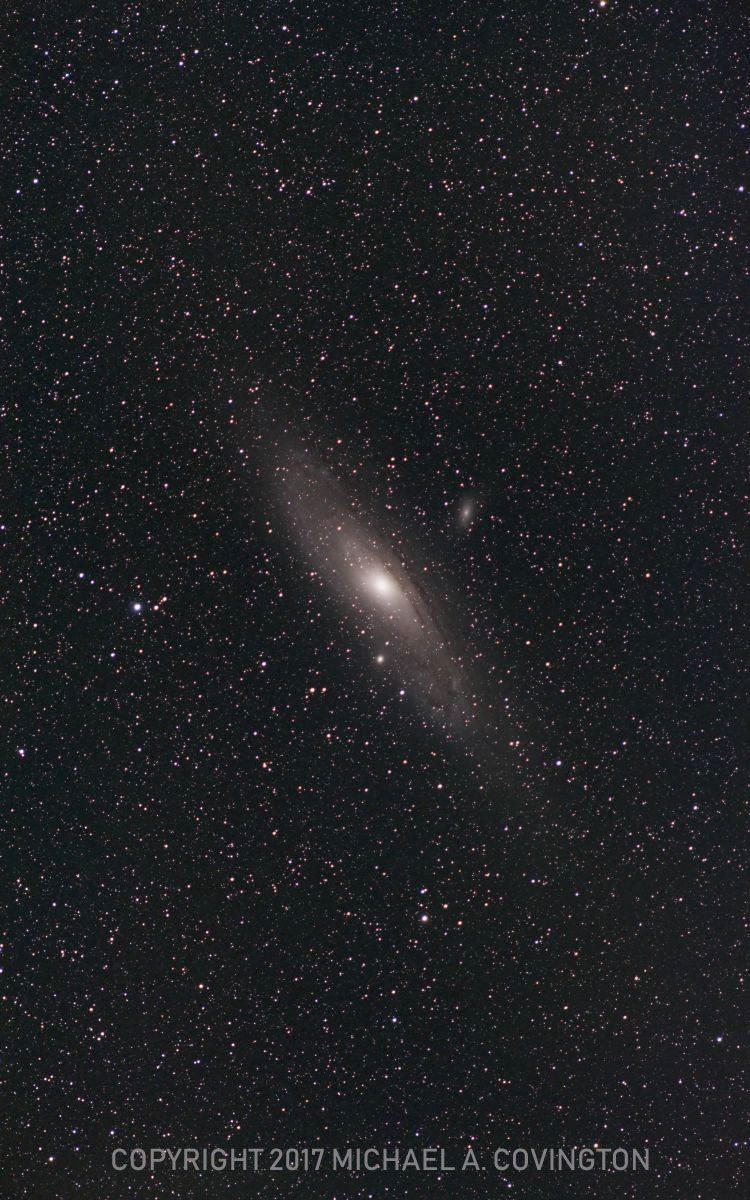
Here's M31 photographed much the same way as last time (scroll down), but at f/2.8
rather than f/4. Note that the star images are sharp all the way to the corners.
That is what marks the Nikon 180/2.8 ED AI-S lens (introduced in 1981) as a great lens.
This particular lens has visible
astigmatism
at f/2.8, but this can be cancelled out by focusing carefully.
I have learned to focus for maximum visibility of the faintest stars.
That minimizes astigmatism but not chromatic aberration;
the brightest stars have vivid red halos! Here's an enlarged
section from a picture taken at f/2.8:
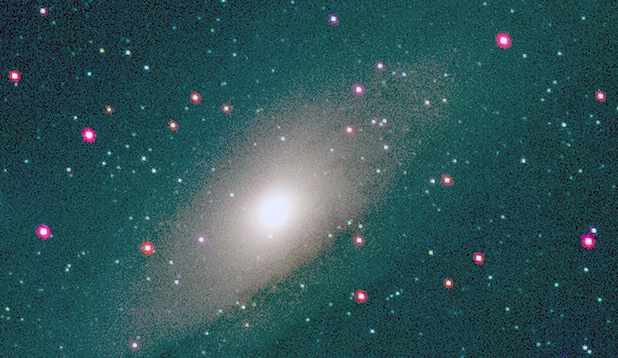
The astigmatism and the halos would probably never have been visible on film;
they go away when I downsample the images by a factor of 4 or 5 to simulate the
resolution of film. Modern digital sensors can detect flaws even in excellent lenses.
How do I put a telephoto lens on a telescope mount?
If the lens has a tripod collar, it's easy
(click here to see my Canon 300-mm lens in action),
but this one doesn't; almost the entire barrel rotates when it focuses.
So I support it with rings like this:
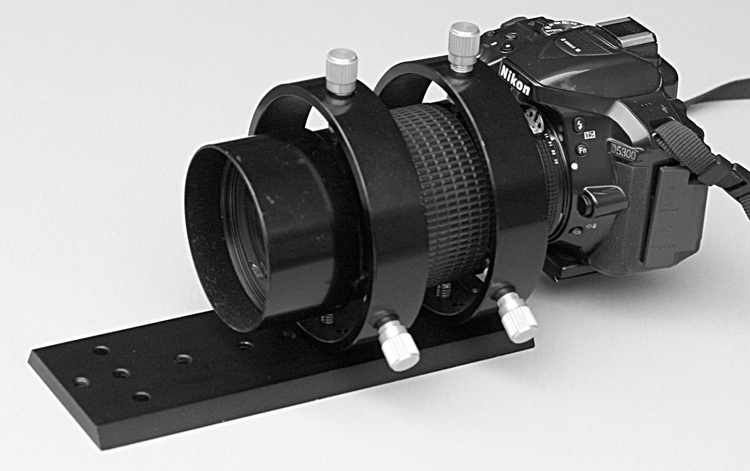
as advocated by Jerry Lodriguss.
Note that the astrophotos above and below were taken with a Canon body using a lens adapter,
and I have recently moved the front ring farther forward.
Permanent link to this entry


|
2017
December
10
|
Yes, I still do astrophotography
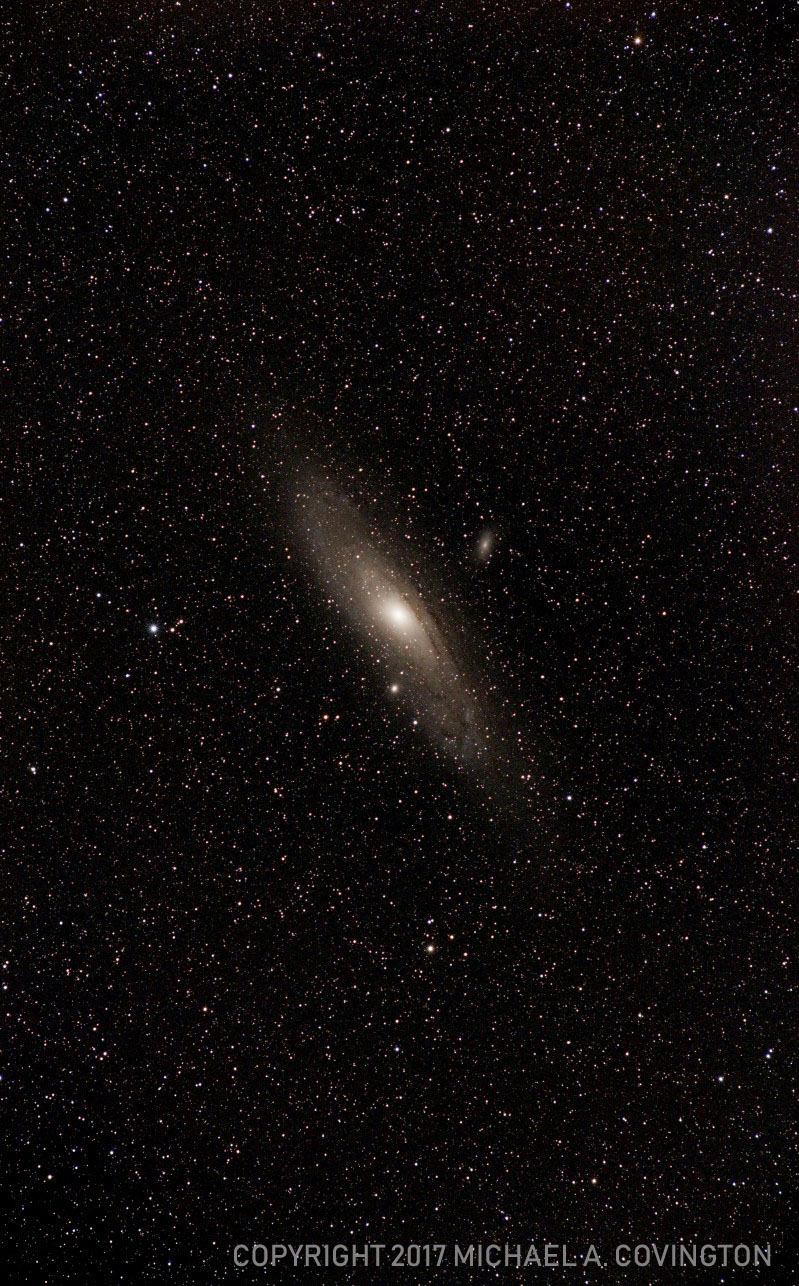
This picture of the Andromeda Galaxy is actually a lens test.
It's a stack of ten 2-minute exposures with a Canon 60Da at ISO 800,
a lens mount adapter, and my
Nikon 180-mm f/2.8 ED AI-S lens,
which I bought a couple of years ago but have just had repaired by
Camera Service Co., whom I recommend.
(It had a sticky diaphragm.)
I supported it on the AVX mount using
a dovetail bar and two rings
(click on the link and scroll down).
This is an excellent lens, but not a perfect one. Introduced in 1987, it raised
the standard for long telephoto lens performance.
Mine, however, shows slight astigmatism at f/2.8 (wide open),
and slight chromatic aberration at f/4.
These faults might have been very hard to detect with film, but
digital sensors are about 5 times sharper.
Even with film, I was troubled by chromatic aberration in the
Olympus 180-mm f/2.8 lens I used to have; this one is much better.
I plan to use this lens regularly at f/4.
It performs very well.
Also, in the spring, after getting my book manuscript finished,
I plan to have an "old-lens festival" in which I star-test my whole
collection of lenses, some very old and undistinguished
(like the Promaster 135/2.8 that normally does service as a paperweight
on my desk). In my copious spare time, of course!
Permanent link to this entry


|
2017
December
2-9
|
To my fellow Christians, about sexual harassment
Society's sudden concern about sexual harassment has given us an unprecedented opportunity to
tell the world what we stand for, if we'll jump up and do the job.
Key point: Our morality is not a set of thou-shalt-nots, it's a set of
values — that is, it's a conviction that certain things are valuable.
Sexual intimacy isn't dirty, it is valuable, so valuable that it is
reserved for couples who have made a permanent commitment to each other.
We call it marriage, and we don't mean a piece of paper that can be torn up by mutual consent
in a quickie no-fault divorce. We mean a real commitment.
What we are really against is meaninglessness.
People aren't objects from whom sexual pleasure is to be taken.
They are human beings every bit as dignified as ourselves.
Their feelings matter, and their immortal souls.
And our morality isn't "traditional morality" if by that you mean
traditional hypocrisy and immorality and prudery.
We need to say this very loudly.
We don't want to go back to 1950.
We want to go forward to the Kingdom of God.
Spread the word. Feel free to share links.
Permanent link to this entry
Good food returns to Covington Manor
Last night (December 8) marks a milestone: Melody and Sharon cooked an excellent
dinner of baked salmon and vegetables. It may be the best salmon I've ever eaten.
Ever since Melody started having a lot of trouble walking (three years ago!) we
have relied heavily on convenience foods, takeout, delivery, and eating out.
Since she got up and about, three or four months ago, I have taken her out to dinner
almost every night. (I don't mind having hundreds of dinner dates with my beloved,
making up for lost time!) But now normal cooking has resumed. The food will be
much better for us because it doesn't have calories secretly inserted by whatever
stealth technology the restaurants employ.
Permanent link to this entry
Sears on the decline
Sears, Roebuck & Co. is not long for this world. In their Athens store, their tool
department looks pitiful. If you need a saw blade, don't go there. The only items that
are abundant are Christmas gift packages, which are mostly socket sets in a great variety
of sizes.
Back in the 1960s and 1970s, the Sears tool department was an important part of every town.
I enjoyed going to the Valdosta Sears regularly with my father around 1965; one day we met
Captain Mercury (a children's TV personality), who was making a public appearance.
More often I marvelled at the gadgetry. I remember once encountering a
pillow block
and wondering what kind of big machine it was for. I have, and use, a C-clamp that
we bought there.
Valdosta's Sears moved from Brookwood Plaza to Valdosta Mall in the 1980s and will close
next month. Athens' Sears has not been announced as closing, but we don't know how long
it will last.
The Sears tool department had two cultural aspects that stand out.
One was the policy of free replacement of any Craftsman hand tool that "fails to give
satisfaction." I have brought them worn screwdrivers and pliers — regardless of
who originally bought them when — and gotten free replacements on the spot.
The other was prolonged support of older products. You could get blades for saws that
hadn't been sold for 20 years. My 1994 8-inch table saw came from Sears and was basically
the last surviving member of a 1960s product line (all newer table saws are 10-inch).
Until just a few months ago, 8-inch blades, rare elsewhere, remained abundant at Sears.
Permanent link to this entry
Current events
Atlanta has just had an unusual snowstorm; we haven't.
Bitcoin has had a wild run-up and is now fluctuating wildly, by 20% or more within hours.
That makes it useless.
Econ 101 tells us money is supposed to be a medium of exchange (for trading),
a store of value (for saving),
and a unit of account (for measuring and setting prices).
By fluctuating wildly, Bitcoin is no use for any of these.
And it is completely unbacked — "backed by the full faith and credit of nobody,"
as I express it.
When people become conviced the Bitcoin bubble is over, they will all want to take
their money out at the same time; everyone will sell at once, and the price will come
crashing down again.
And many of those fortunes never existed. Put $1000 in, watch it skyrocket to $150,000,
watch it crash back down to $500, and take your money out. Where's the wealth?
North Korea is a small dictatorship with no allies. Naturally, it wants to be able to
defend itself. Unfortunately, it has achieved nuclear weapons.
I think the right way to deal with it is to avoid provoking accidental war,
equip ourselves to intercept missiles if North Korea launches them,
and wait for (and try to hasten) an internal collapse, as happened with the
Soviet Union.
Above, note that Kim Jong-Un's rhetoric about the inevitability of war is the same
as he has been spouting for a long time.
Despite the impression given by some news media, these are not new threats.
Please note that these are my non-expert opinions, as a citizen. Although I work
in defense analysis on another level, I have no training or inside information about
strategies for dealing with North Korea.
How did Tycho Brahe polar-align the
Great Equatorial Armillary?
I'm about to dig into his writings to try to find out.
It was one of the first precision equatorial mounts in history.


|
2017
December
1
|
My fellow Americans!
Yesterday our President used Twitter to distribute three anti-Muslim propaganda videos from a
fringe group in Britain. All three were quickly traced to their sources and found to have been
misrepresented. The President's press office then said that it didn't matter whether they were
real as long as they "start a conversation."
Today we had, from a former national security advisor, a confession of collusion between the Trump
campaign and the Russians.
If I could say only one thing to my fellow Americans during the current political turmoil, it is this:
You have to care about facts, even when facts are complicated. It's not enough to just take sides based on labels or blind loyalty.
Permanent link to this entry
中文
On a happier note, today begins, I suppose, my study of the Chinese language.
I don't plan to go very far with it, but it's involved in one of my projects, so I might
as well start dabbling. Chinese is a language in which vocabulary takes you a long way;
there are no verb or noun systems to learn as in French or Latin.
The characters you see above are pronounced Zhōngwén and mean, literally,
"central language." China calls itself 中 ("middle") because it's the middle of
the known world (if you're Chinese).
Permanent link to this entry


|
|
|
This is a private web page,
not hosted or sponsored by the University of Georgia.
Copyright 2017 Michael A. Covington.
Caching by search engines is permitted.
To go to the latest entry every day, bookmark
http://www.covingtoninnovations.com/michael/blog/Default.asp
and if you get the previous month, tell your browser to refresh.
Portrait at top of page by Krystina Francis.
Entries are most often uploaded around 0000 UT on the date given, which is the previous
evening in the United States. When I'm busy, entries are generally shorter and are
uploaded as much as a whole day in advance.
Minor corrections are often uploaded the following day. If you see a minor error,
please look again a day later to see if it has been corrected.
In compliance with U.S. FTC guidelines,
I am glad to point out that unless explicitly
indicated, I do not receive substantial payments, free merchandise, or other remuneration
for reviewing or mentioning products on this web site.
Any remuneration valued at more than about $10 will always be mentioned here,
and in any case my writing about products and dealers is always truthful.
Reviewed
products are usually things I purchased for my own use, or occasionally items
lent to me briefly by manufacturers and described as such.
I am an Amazon Associate, and almost all of my links to Amazon.com pay me a commission
if you make a purchase. This of course does not determine which items I recommend, since
I can get a commission on anything they sell.
|
|
















